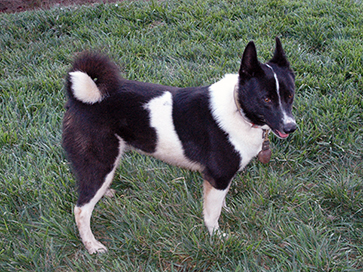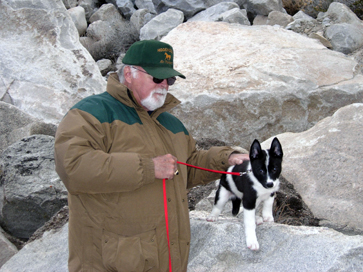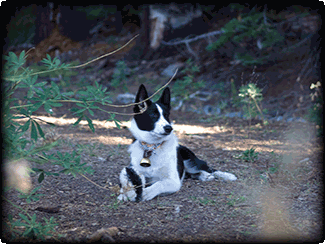Our dog training principles
By Bill Fantozzi and Bill Bates
Trainers for California Karelians
For generations, man has bred dogs to perpetuate certain characteristics, such as temperament, size, color, hair length, agility, and stamina. Currently, the American Kennel Club (AKC) recognizes more than one hundred breeds of dog, which are further broken down and classified into six major groups, including the Sporting Group, Working Group, and Hound Group. Other countries such as Canada, England, Mexico and Finland have their own registries.

An accepted standard exists to describe the qualities that define each breed of dog. This accepted standard will tell you what dogs of that breed should look like in specific detail. For example, the accepted Dog Standard might read:
NOSE- large, black, broad bridge
CHEST- broad, deep, well defined
FORELEGS- straight, strong, parallel.
While most people can describe with specificity what a particular breed should look like, they become rather general when discussing temperament and ability. Indeed, within each breed, there are certain lineages (blood lines or genetics) that have stronger instincts than others. In reality, not all water dogs like to swim, not all retrievers will retrieve, not all pointers point and not all German Sheppard’s make good police dogs. Moreover, each animal has his/her own personality and temperament within the broad description of temperament that is generally accepted for the breed.
It is in respect of these individual variations that our training philosophy at California Karelians departs from more common training approaches. We believe that a good trainer will recognize and capitalize on the natural instincts that each individual dogs possesses.
Just as no two dogs will respond exactly alike to the same training technique, setting a rigid expectation as to what will be accomplished in a single training session is ill advised. Even dogs can have a "bad" day. The key is to train the dog based on how the dog responds in each particular training session. If you need to go back and reinforce something the dog appeared to have "mastered," don't get discouraged. Understanding and patience are as important as consistency and good training technique. Training should be enjoyable for both you and your dog.

|

While not all inclusive, the following principles reflect the way we relate to, and train, California Karelians:
 We strive to be conscious of each dog’s individual personality and temperament and are sensitive to how he/she responds to leash correction. Among individual animals of any breed, indeed within any species, differing personalities are a survival tool. Accordingly, we apply methods of correction that are best suited to the personality and age of each dog. We strive to be conscious of each dog’s individual personality and temperament and are sensitive to how he/she responds to leash correction. Among individual animals of any breed, indeed within any species, differing personalities are a survival tool. Accordingly, we apply methods of correction that are best suited to the personality and age of each dog.
 We pay particular attention to each dog’s body language. The mere look in the dog's eyes can tell you what it is thinking or feeling. We pay particular attention to each dog’s body language. The mere look in the dog's eyes can tell you what it is thinking or feeling.
 We make certain our dogs understand what behavior we expect by maintaining a steady delivery of training iterations, gradually increasing the difficulty. When the dog demonstrates that it understands what is being asked, and only then, we add new challenges. We make certain our dogs understand what behavior we expect by maintaining a steady delivery of training iterations, gradually increasing the difficulty. When the dog demonstrates that it understands what is being asked, and only then, we add new challenges.
 We never rush, or are impatient about, our training goals. Blind determination to accomplish a specific goal in a specific training session without considering the dog's reaction is the single biggest mistake that a novice owner/handler can make. We never rush, or are impatient about, our training goals. Blind determination to accomplish a specific goal in a specific training session without considering the dog's reaction is the single biggest mistake that a novice owner/handler can make.
 We treat our dogs as long-term companions and value the joy that they bring to our lives. Through our training program, we strive to develop the innate capabilities that Mother Nature has given these truly remarkable dogs. We treat our dogs as long-term companions and value the joy that they bring to our lives. Through our training program, we strive to develop the innate capabilities that Mother Nature has given these truly remarkable dogs.
|